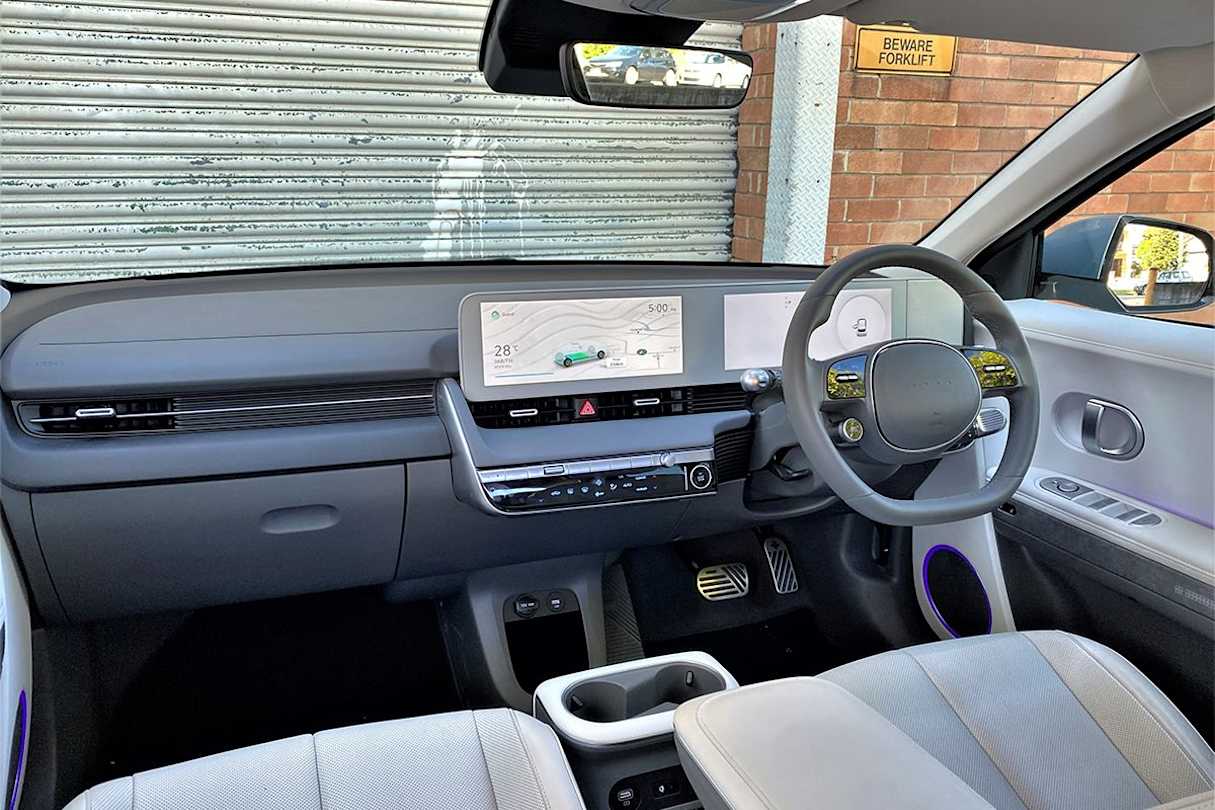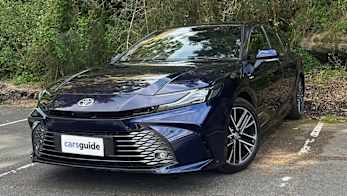The Hyundai Ioniq 5 could well be the ultimate urban car. And what better way to test this claim than with the ultimate urban best friend – Spot. Yes, as you’ll see in the video above I tested the Ioniq 5 with the world’s most advanced robotic dog, and his name is Spot. At least I think it’s a him.
Spot is the most famous creation of Boston Dynamics, the robotics company that also makes the humanoid robot Atlas. What’s the connection? Well, last year Hyundai bought a major stake in Boston Dynamics and, being the nerdy, unashamed robot fan I am, I had to know more. You can read my news stories on Google about when the robot invasion will take place. I’m kidding.
.jpg)
Hyundai wasn’t joking, however, when they asked if I wanted to meet Spot. It was like Christmas multiplied by Easter for me.
And so that’s the story behind the video review of what could be the ultimate urban car with the ultimate urban dog.
And this is the full Urban review of the Ioniq 5 with a bit of help from good boy Spot.
Hyundai Ioniq 5 2022: Awd Extended Range Ev
| Engine Type | Not Applicable, 0.0L |
|---|---|
| Fuel Type | Electric |
| Fuel Efficiency | 0.0L/100km (combined) |
| Seating | 5 |
| Price From | $52,470 - $60,280 |
| Safety Rating |
|
Does it represent good value for the price? What features does it come with?
The Ioniq 5 with all-wheel drive and two motors sits at the top of the range and has a list price of $75,900. I know that sounds like a lot of money for a Hyundai that’s not a giant SUV, but compared to other rival electric vehicles - such as the Tesla Model 3 or Kia EV6 - it’s priced well.
The value for money when it comes to standard features is excellent, too.
Coming standard are two impressive 12.3-inch displays, a Bose sound system, sat nav, Apple CarPlay and Android Auto, dual-zone climate control, leather upholstery, power-adjustable front seats – they’re heated and ventilated, too – a proximity key and retractable door handles.

The LED headlights with black bezel pixel graphics are also standard, as are the taillights, along with the 20-inch alloy wheels and smart cruise control.
.jpg)
If you still think that’s expensive, at least it’s more affordable than Spot. Spot’s price is about $100,000, and you can’t even ride on him. He does have some pretty amazing standard features, though. Spot has five cameras and can see in infrared and through 360 degrees, he can carry 14kg, run at almost 6km/h and function at -20C. He can also dance – I’m serious, watch the video and be amazed.
Is there anything interesting about its design?
Is the Ioniq 5 an SUV or a hatchback? Well, it’s classified as an SUV. You could call it a crossover, too. It could be the future of car design, in that it’s a bit of both. Maybe if I tell you why it’s designed this way it might make a bit more sense.
The Ioniq 5’s looks are a homage to Hyundai’s first big hit – the Pony hatchback. And much like the new-age Mini, the designers have created something that looks incredibly cool and modern while keeping many of the hallmarks of the original.
Just look at its face and those LED headlights. I can’t decide if I like the front more than the back of the car, with its dot-matrix taillights and floating Ioniq 5 badge.
It’s retro cool done right.
The Ioniq 5 is more SUV than little hatchback, its wheels have been taken and sent to the furthest corners of the car, giving it the wheelbase of a large SUV while staying the length of a mid-sized SUV, and that’s good for tight parking spots.

Cars with long wheelbases tend to have better cabin room , and Hyundai has designed one that’s almost as large as you can get inside for its length.
End-to-end, the Ioniq 5 is 4.64m long, which is about the length of a Kia Sportage or Subaru Forester.
The Ioniq 5’s interior isn’t as impressive as its outside – again, it’s a tribute to the cabin of the original Pony, but it doesn’t feel as though the futuristic, high-end feel of the exterior has been matched in here.
There are the large screens for media and your instrument cluster, but Hyundai missed an opportunity to build a dash that would blow our minds. Instead, it feels like it’s the car interior version of an iMac from 2005, with its heavy use of white plastic. The white-leather upholstery on my test car didn’t help, and the muted grey trim was also uninspiring.
I can see what Hyundai’s designers were trying to do, because when you look at images of the original Pony’s cabin it makes sense (Google it and you’ll see), but the incredible looks of the exterior outdo the cabin styling.
Spot doesn’t have any fur, but he does have Kevlar armour – those are the yellow bits. It also looks like Spot is missing his head, but he’s not – that’s just what his face looks like... or is that his bottom? It’s hard to tell. An arm attachment with a clamping, hand-like feature can be fitted to his face, too, which sounds creepy, and it is. You should see him when he uses it to open doors.
How practical is the space inside?
The Ioniq 5 is a room with four wheels. That’s how it feels to sit inside. That’s because, as I mentioned earlier, the vehicle’s wheels have been positioned at the furthest reaches of the car, giving the Ioniq 5 a three-metre wheelbase. And because passengers sit between the front and rear wheels of a car, in this case they’ve been given more room.
So you get a whole room on wheels. All while keeping the overall length of the car down to 4.64m. Clever.
So, rear legroom for me, even at 191cm tall, is so good that I can sit behind my driving position with about 15cm to spare, and headroom back there is excellent, too.

Storage is also vast, with a sliding centre console, cup holders and door pockets.
The are two boots – one at the back with a cargo capacity of 427 litres (VDA) and one at the front under the bonnet that has a 24-litre volume.
For charging devices there are two USB ports up front and two in the second row.
The concrete jungles of Australia’s streets get hot in summer, but the rear windows are heavily tinted and have pull-up sunshades. Directional air vents for the second-row occupants are great to see as well.
Spot doesn’t have a boot, but he can carry up to 14kg on his back.
What are the key stats for the motor and transmission?
The all-wheel-drive Ioniq 5 I tested has two motors, one at the front and one at the rear. The front motor produces 70kW and 255Nm, while the rear makes 155kW and 350Nm.
The Ioniq 5 all-wheel drive has superb acceleration, with 0-100km/h coming in 5.2 seconds.
Urban cars really don’t need all-wheel drive, but it can provide extra traction in the wet, and that’s good for safety. If the budget doesn’t stretch to the dual-motor all-wheel-drive version of the Ioniq 5, go for the rear-wheel drive with the single motor.

The Ioniq 5 has a liquid-cooled lithium-ion battery with a capacity of 72.6kWh. The large onboard 10.5kW inverter means charging is quick and with a 50kW fast charger you can fill the battery from 10 to 80 percent in 61 minutes and 42 seconds.
At 100 per cent charged, Hyundai says you’ll have a 430km range (WLPT).
Realistically, the range will depend on how you drive the Ioniq 5, and blasting cold air on a hot day via the climate control can also drop the range significantly in any electric car.
There is not a better powertrain for an urban car than an electric one. Environmental benefits aside, they’re just incredibly smooth and easy to drive in traffic with no changing gears, no noise and instant and strong acceleration on tap.
The same goes for Spot. A petrol-powered Spot would be ridiculous and probably very dangerous in a city apartment.
How much energy does it consume?
Hyundai says that after a combination of open and urban roads the Ioniq 5 should use 19kWh/100km. I only tested the Ioniq 5 in the city where, after almost 200km, the trip computer was reporting 16.1kWh/100km.
The Ioniq 5 is also a bit like a mini power station, and you can use it to provide electricity through a regular plug-in power point.
I was able to charge Spot, for example, using the Ioniq 5.
Spot take two hours to charge and has a run time of about 90 minutes.
Warranty & Safety Rating
What safety equipment is fitted? What safety rating?
The Ioniq 5 was given the maximum five-star ANCAP rating when it was tested in 2021. The advanced safety tech on board is outstanding.
Coming standard is AEB, which can detect cyclists and pedestrians. That AEB system also works at intersections and will brake automatically when reversing if it detects an obstacle. That’s in addition to rear cross traffic alert, blind-spot warning with avoidance steering, lane-keeping assistance and adaptive cruise control.
Spot also has crash-avoidance systems and uses five cameras to see the world in 360 degrees. Spot can also autonomously navigate himself from one place to another. He can maintain his balance perfectly and if you happen to knock him over, as I did in the video, he’ll get back up again.
What does it cost to own? What warranty is offered?
The Ioniq 5 is covered a five-year/ unlimited-kilometre warranty. The battery has an eight-year/160,000km warranty.
Services are needed every 15,000 kays or 12 months and the servicing over five years comes to about $340 per service.
What's it like to drive around town?
Nothing beats an electric car for driving in city traffic. I’m serious, and this from a bloke who loves V8s and has owned several manual-transmissioned muscle cars. My left leg is still shaking from holding the clutch in on hills.
The Ioniq 5 has just one gear, all you need to do is accelerate and brake, and your motion is superbly smooth and instant.
There’s actually almost no need for a brake pedal, either. If you set the regenerative braking high enough, just taking your foot off the accelerator will slow the car down almost to a standstill very quickly.
The Ioniq 5 accelerates hard when you need it, which is great for merging into traffic or moving quickly out of car spaces or turning at intersections.

It’s not just about acceleration, the ride is also super comfortable, thanks to that long wheelbase and a good suspension, wheel, and tyre set-up, while handling is impressive, too.
And the Ioniq 5 does it all in silence. Well, at low speeds it emits an artificial hum to warn pedestrians you’re coming, but that's it.
Thin A-pillars and large window make for great visibility, while crystal clear camera pictures help, too. There's even automatic parking for both parallel and perpendicular spots.
Verdict
The Ioniq 5 all-wheel drive is an outstanding urban car. It’s electric and is effortless to pilot through horrendous city traffic, while being comfortable, spacious, and practical. It’s also quick to charge, with a 400km-plus range, and it's safe, too, with the latest crash-avoidance technology. Arguably, though, the ultimate urban car is the not this all-wheel drive version, but the rear-wheel drive – it has all the same features, but for less money. I’m going to give the all-wheel drive Ioniq 5 I tested 4/5.
As for Spot, well, this is the ultimate urban dog, and not just because he never needs the bathroom. I’m giving Spot five out of five.
Pricing Guides










.jpg)
































.png)



.jpg)




